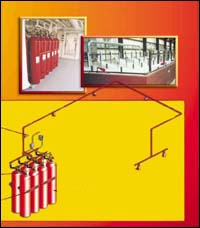Shipyard Employment eTool
Fire Protection >> Fixed Fire Extinguishing System Hazards on Board Vessel

Fixed fire extinguishing systems on vessels and vessel sections may create a dangerous atmosphere when such systems are accidentally activated. Several accidents involving fixed fire extinguishing systems have resulted in fatal injury. When employees must work in a space on a vessel that is protected by a fixed fire extinguishing system, specific requirements must be followed. These include:
- Isolating the system or otherwise prudent discharge.
- Training workers on precautions when entering a space with an armed system.
- Working with an extinguishing system.
The following identify potential hazards and requirements:
- Fire extinguishing
- Training. See Fire Protection: Training for specific requirements.

Potential Hazards
- Accidental discharge of fire extinguisher.
- Miscommunication and coordination with:
- Ship owner and prime contractor
- Prime contractor and subcontractor

Requirements and Example Solutions
- When active fixed extinguishing systems could create a dangerous atmosphere in vessels and vessel sections: [1915.506(a)]
- Physically isolate the system or use other positive means to prevent the systems' discharge. [1915.506(b)(1)]
- Ensure that employees are trained to recognize: [1915.506(b)(2)]
- Systems' discharge, evacuation alarms and appropriate escape routes. [1915.506(b)(2)(i)]
- Hazards associated with the extinguishing systems and agents including the dangers of disturbing system components and equipment (such as piping, cables, linkages, detection devices, activation devices, and alarm devices). [1915.506(b)(2)(ii)]
- During sea and dock trials, all systems must remain operational. Ensure that: [1915.506(c)]
- All doors, hatches, scuttles, and other exit openings remain working and accessible for escape in the event that the systems are activated. [1915.506(d)(1)]
- All inward opening doors, hatches, scuttles, and other potential barriers to safe exit are removed, locked open, braced, or otherwise secured. [1915.506(d)(2)]
- When testing a fixed extinguishing system, all workers must be evacuated from the space during discharge. Oxygen level must be tested to ensure safe conditions prior to workers reentering the space. [1915.506(e)]
- Fixed extinguishing system must be physically isolated before conducting maintenance on the system. [1915.506(f)]
- When fixed manual extinguishing systems are used to provide fire protection for spaces in which work must be performed, ensure that: [1915.506(g)]
- Only authorized workers are allowed to activate the system. [1915.506(g)(1)]
- Authorized workers are trained to operate and activate the systems. [1915.506(g)(2)]
- All workers are evacuated from the protected spaces, and accounted for, before the fixed manual extinguishing system is activated. [1915.506(g)(3)]

- When a fire extinguishing system is active:
- Post signs at gangway and space.
- Provide emergency escape respirators should be provided.
- Maintain a sign in and out log.
- Lock and tagout when working on the system.
- Evaluate and assess hazards of halon used in the extinguishing system (Figure 4).
- Sample Fire Safety Plans. Shipbuilders Council of America, (2006).

